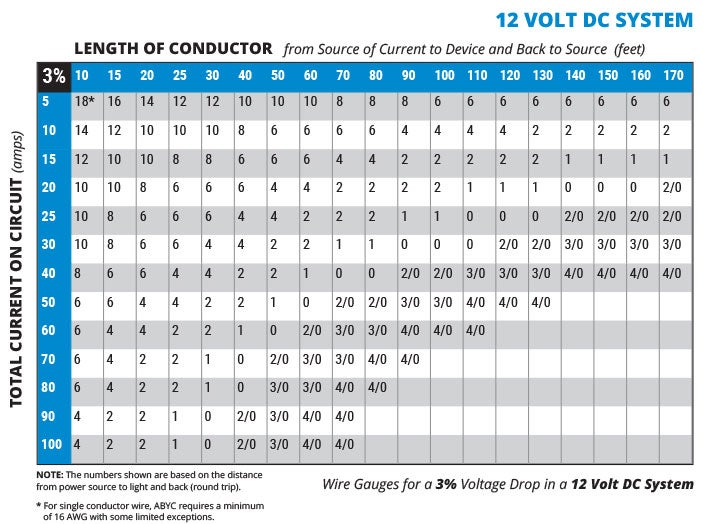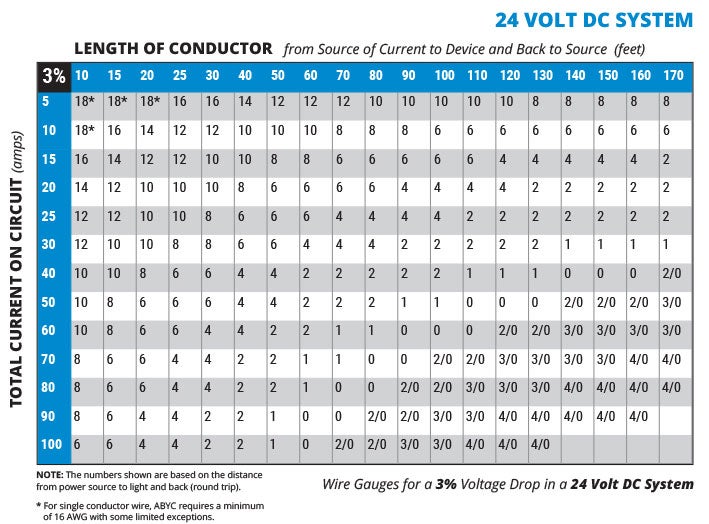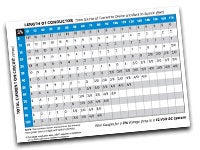Selecting The Correct Wire Gauge for Your Lights
Simple Rule of Thumb Equation:
(Distance from Battery to Light x 2 = Total Wire Run)
In the U.S., wires are sized by the AWG (American Wire Gauge) system. The higher the AWG number, the smaller the wire diameter.Typically, an installer will select the smallest wire they can for their application to save on material cost.
What you need to know ahead of time:
- Your vessel’s system voltage, this is typically (12V or 24V).
- The total current draw of the number of lights you are planning to power on the circuit. This will depend on system voltage, (Lumitec light current draw information for 12vDC and 24vDC is found on the light product pages on this website). If powering multiple lights add up the current draw per light rated for your system voltage.
- Distance of wire run (from the power source to the light AND BACK).
- Your voltage drop requirement (Lumitec always recommends using 3%) - Voltage drop is the change in voltage along the wire due to resistance in the wire.
Determine the correct wire gauge by using one of several tools:
- Wire gauge table charts below (select the table for your system voltage).
- An Online Calculator (we recommend this one Link Here)
- ABYC Wire Sizer App (Available on Apple Store and Google Play).
Some things to be aware of:
- ABYC requires minimum of 16AWG on most single conductor wire runs (so even if the table or calculator says 18AWG, you should use 16AWG if running a single wire).
- A boats battery doesn’t always produce 12V, and can run as low as 10V under certain operating conditions, or up to 14V when charging. This changes the current drawn by the lights and can sometimes require selecting a larger wire size. A good rule of thumb is to use the next heavier gauge when possible.
- When Planning the Wire Run:
- Do not run in parallel in the same bundle or conduit as low voltage signal cables such as audio input wires. This helps avoid picking up noise in your audio system.
- Use a common ground near the battery and DO NOT connect into a long shared ground line that boats sometimes have, otherwise this can add noise to speaker systems.
- Audio system and lighting system incoming power should not share the same terminal blocks to help prevent a buzz sound on the speakers.
- Avoid making right angle turns on sharp edges as this will eventually cut through the wire insulation, use grommets where necessary.
- In the Marine industry, you MUST use adhesive lined butt connectors to prevent moisture from ruining the connection. Any exposed metal of the wire is a point where moisture can travel along the wire and get into the electronic components at the end of the wire.
Information was referenced from: ABYC E-11: AC & DC Electrical Systems on Boats. More information can be found at Link Here
12 VDC Wire Gauge Chart
Use the chart below for when selecting the correct wire gauge when working with a 12 volt DC electrical system.


24 VDC Wire Gauge Chart
Use the chart below for when selecting the correct wire gauge when working with a 24 volt DC electrical system.


NOTICE: Although this process uses information from ABYC E-11 to recommend wire size and circuit protection, it may not cover all the unique characteristics that may exist on a boat. If you have specitic questions about your installation please contact an ABYC certified installer.


